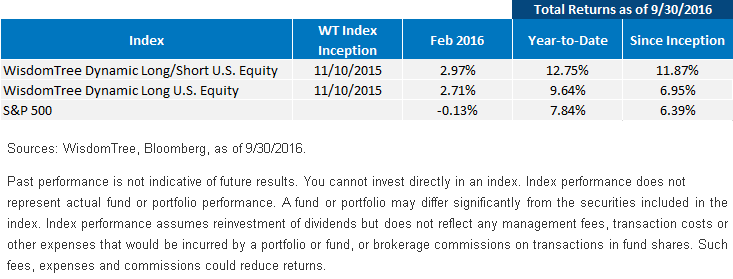The Long Portion of WisdomTree’s Long/Short Strategy



WisdomTree launched the WisdomTree Dynamic Long/Short U.S. Equity Fund (DYLS) late last year to give investors a way to dial down their exposure to the U.S. equity market when fundamentals deteriorate. Heading into 2016, the Index that DYLS seeks to track, the WisdomTree Dynamic Long/Short U.S. Equity Index, provided a market-neutral exposure: it counterbalanced its long positions by shorting S&P 500 Index futures for the month of January and February. Starting on March 2 and through the month of September, the strategy has been 100% long. So how has the long portion of this strategy performed in 2016?
Total Returns as of 9/30/2016

With 180 basis points (bps) of outperformance over the S&P 500 Index year-to-date, the WisdomTree Dynamic Long U.S. Equity Index—the long portion of the WisdomTree Dynamic Long/Short U.S. Equity Index—has shown its potential to generate alpha. Since its inception in November 2015, the long portion of the Index has beaten the S&P 500 by 56 basis points. How did the Index achieve this?
Two factors—growth and value—determine which companies are selected, and one factor—volatility—drives their weight in the WisdomTree Dynamic Long U.S. Equity Index. Stocks earn a growth score and a value score based on various measurements relevant to the sector they come from. Stocks with the highest scores are selected each quarter and assigned weights so that overall sector exposure is similar to the market. However, rather than weighting by a company’s market value, WisdomTree sets weights based on a stock’s volatility multiplied by its beta, in effect rewarding lower-volatility stocks with greater weights and refreshing those weights through a quarterly rebalance. This weighting methodology, along with sector constraints, helps the long Index correlate with the broader movement of the market while also providing the potential for some measure of downside protection.
For example, in February, the month that saw the bottom of the S&P 500 and the peak of the VIX year-to-date, the WisdomTree Dynamic Long U.S. Equity Index outperformed the S&P 500 by over 280 bps. Put another way, the WisdomTree Dynamic Long U.S. Equity Index combines quality and value in the selection process and low volatility in the weighting process in a sector-neutral attempt to add alpha on the long side of the portfolio.
Despite the efficacy of the WisdomTree Dynamic Long U.S. Equity Index, one must remember that it is actually only one half of a “Dynamic Duo.” On a monthly basis, a hedging indicator will inform the WisdomTree Dynamic Long/Short U.S. Equity Index how much net equity exposure it wants to take on, be it 100%, 50% or 0% (market neutral). This is done by maintaining the long portion of the portfolio and shorting S&P 500 Index futures to achieve the indicated net equity exposure. It helps to think of the hedging indicator as a signal for potentially higher, medium or lower beta to the S&P 500 Index—higher beta being 100% net equity exposure, medium beta being 50% net equity exposure, and lower beta being 0% net equity exposure. The key drivers for 100% net equity exposure are expanding profits, as measured by operating profit margins, net income profit margins and profit quality. In addition, value indicators—as measured by price to book and price to cash flow—also contribute to the net equity exposure decision on a month-to-month basis. These same signals moving in the opposite direction would trigger a market-neutral position, while a mixture of readings would advise the Index to proceed with caution, or 50% net equity exposure. It is important to note that if the monthly signal is 50% net equity exposure or market neutral at a time when the market is rallying, the WisdomTree Dynamic Long/Short U.S. Equity Index will likely experience less of that upside gain. Likewise, if the signal is 100% net equity exposure when the market is falling, it could experience losses in line with those of the S&P 500 Index.
Conclusion
The WisdomTree Dynamic Long/Short U.S. Equity Index provides an interesting take on “active” downside protection. By maintaining long exposure to what we believe is a fundamentally sound, low-volatility-weighted basket of stocks, the potential for alpha always exists. Yet by using a monthly hedging indicator and changing net equity exposure by shorting S&P 500 Index futures, the beta of the strategy to the S&P 500 can change on a monthly basis, providing the potential for downside protection. We believe that as long as the hedging indicator continues to be accurate more often than not, the WisdomTree Dynamic Long/Short U.S. Equity Index has the potential to generate higher risk-adjusted returns and to complement broader equity exposure as an alternative allocation strategy.
Important Risks Related to this Article
There are risks associated with investing, including possible loss of principal. The Fund invests in derivatives, including as a substitute to gain short exposure to equity securities. Derivative investments can be volatile, and these investments may be less liquid than other securities, and more sensitive to the effects of varied economic conditions. Derivatives used by the Fund to offset its exposure to market volatility may not perform as intended. The Fund may engage in “short sale” transactions and will lose value if the security or instrument that is the subject of a short sale increases in value. A Fund that has exposure to one or more sectors may increase the Fund’s vulnerability be more vulnerable to any single economic or regulatory development. This may result in greater share price volatility. The composition of the Index is heavily dependent on quantitative models and data from one or more third parties, and the Index may not perform as intended. The Fund invests in the securities included in, or representative of, its Index regardless of their investment merit, and the Fund does not attempt to outperform its Index or take defensive positions in declining markets. Please read the Fund’s prospectus for specific details regarding the Fund’s risk profile.
The composition of the Index is heavily dependent on quantitative models and data from one or more third parties, and the Index may not perform as intended. The Fund invests in the securities included in, or representative of, its Index regardless of their investment merit, and the Fund does not attempt to outperform its Index or take defensive positions in declining markets. Please read the Fund’s prospectus for specific details regarding the Fund’s risk profile.



